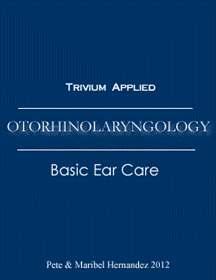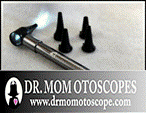Trivium Applied: Otorhinolaryngology (Basic Ear Care)
Pete and Maribel Hernandez
Copyright 2012
All rights reserved.
The hearing ear and the seeing eye, the LORD hath made them both.
Proverb 20:12
I would like to lay out a small 3-step plan for using the trivium as a spring board to learn how to use an otoscope -— a medical specialty learned in otorhinolaryngology.
If the reader is wondering “what does Teaching the Trivium: Christian Homeschooling in a Classical Style have to do with otorhinolaryngology,” I’ll explain. Over ten years ago when I began using this book in my homeschooling, I quickly realized I should take advantage of other applications the book did not mention. I asked myself “if I can teach my children to learn on their own, what stops Mom from doing the same.” The authors did not write this book to teach us how to use an otoscope, but they provided me with a priceless tool to learn on my own. Could I share with you how?
What is the Trivium Three roads to learning. This is the biblical model for learning. Proverbs 2:6, 8:12, 15:14, l8:15, 23:12, 24:3. The first road is grammar, where we gather facts. This is followed by logic, which is understanding. Lastly is rhetoric — this is where we execute a plan.
What is otorhinolaryngology It is pronounced (o·to·rhi·no·lar·yn·gol·o·gy). The “ot” means ear, “rhino” means nose, “laryn” means throat, “o” is the connecting vowel and “logy” is the science or study of. It is also known as ENT —- ear, nose and throat. The name was inappropriately shortened in 1980 to “otolaryngology.” It will teach you how to deal with common ear, nose, and throat conditions. Head and neck surgery are outside the scope of this article. This specialty involves ear conditions of patients of all ages. Some common conditions are: earache, ear infection, hearing loss, and tonsillitis (inflammation of a tonsil).
Parts of an Ear
Anatomically, the ear is divided into three parts:
External (1/2 cartilaginous & 2/3 bony)
Middle (contains 3 tiny bones: malleus, incus and stapes)
Inner (referred to as the labyrinth)
What is an otoscope
It is a small portable hand held tool for viewing inside the ear canal to detect ear conditions. It has a head, body, handle, lighting, and magnification. This tool is taught in a medical school; the specialty is called otorhinolaryngology. However, homeschool parents don’t need to pay huge amounts of money at medical school.
Why learn this tool
-
-You can view the entire ear, nose and throat system.
-It will allow parents to reduce or eliminate expensive pediatric bills. How? By using various botanical oils that have ear application like, Mullein
-It brings utility to others by teaching them how to use an otoscope.
-Otoscope skills can be incorporated into your homeschool curriculum.
Anyone can study otorhinolaryngology (ear care) using any approach, however, it is much easier if you use the trivium model of learning.
The trivium applied to “otorhinolaryngology (ear care)” functions in three distinct stages and would look something like this.
Step 1
GRAMMAR STAGE (facts)
In the grammar stage the parent/student gathers facts on “what is an otoscope”? It is a hand-held portable device that allows for viewing inside the ear canal. What can I view with an otoscope? You will view the tympanic membrane (TM). A healthy TM is usually gray, pale, and pearly in color. It is a thin semi-transparent membrane situated inside and toward the end of the canal.
The student then takes those facts with him and moves into the second stage.
Step 2
LOGIC STAGE (understanding)
In the logic stage he seeks to understand symptoms associated with conditions affecting the tympanic membrane so he can view ear infections. He might see water bubbles, ear wax, and a forgotten piece of cotton fibers trapped in the ear canal. This is where the student begins to understand how to use his otoscope for viewing common complaints associated with the ear.
Step 3
RHETORIC STAGE (practice)
In the last stage, he gains traction. He executes a plan. This is where the three stages come together in order to put into practice his clinical skills he learned in otorhinolaryngology. When does he use these skills? When he knows and understands the anatomical parts of the ear — he has the facts. When he is able to assess (view the tympanic membrane with an otoscope), he knows their names and understands their location and function. When a middle ear infection is present he will know this because he has been practicing viewing healthy ears. The three stages cohesively form the foundation of the trivium. Finally, he is able to effectuate a gnosis (knowledge), diagnosis (understanding), and a diagnostic (practice) using his otoscope.
And lastly, never skip stages. This results in frustration because parts of the trivium information are missing.
Here are just a few lesson plans parents can start using in their homeschool to teach the grammar stage of otorhinolaryngology. Start a copywork notebook for each of your children if you feel it is grade appropriate.
Grammar Stage: Knowledge of Otorhinolaryngology
Observe the ear from a human anatomy atlas. (check one out from the library)
Write all the external & inner parts of the ear in your anatomy notebook.
Recite the names aloud. (Consult a medical dictionary for correct pronunciation)
Memorize the names.
Outline the names into two sections using a simple sentence. External & Inner parts of the ear.
Copy the names into your “copywork” notebook.
Pronounce all the words of the ear correctly. Read a medical dictionary for this.
Explore the ear through viewing the ear canal with an otoscope
Define all the parts of the ear using a comprehensive medical dictionary.
Identify common diseases relating to the ear. Read Otitis Media in Infants and Children by Bluestone & Klein
Observe the ear in a human anatomy atlas. The Atlas of Human Anatomy by Frank H. Netter will give you excellent drawings of all names of the inner and external ear. Familiarize yourself with the structure of the ear. Look at the corresponding names of the ear parts to their location.
Name all the inner and external parts of the ear. Listen to the pronunciation by Stedman’s Student Value Pack CD-ROM. Published by Lippincott Williams & Wilkins
Write all the external and inner parts of the ear in your anatomy notebook. This will reinforce penmanship in otorhinolaryngology.
External Ear Parts:
Helix
Auricle
Crura of antihelix
Tubercle
Scaphoid fossa
Antihelix
Concha (Cymba & Cavum)
Lobule
Triangular fossa
Crus of helix
Tragus
Intertragic notch
Antitragus
Inner Ear Parts:
Epitympanic recess
Malleus
Incus
Stapes tensor tympani muscle
Cartilaginous osseous
Tympanic membrane
Tympanic cavity
Eustachian tube
Recite the names aloud.
External ear parts:
Hē / liks— helix
Auricle— aw/ri-kl
Kroo/ră— crura
Tubercle— too/ber-kl
Scaphoid fossa— skaf/oyd, fos/ă
Antihelix— an-tē-hē/liks
Concha— kon/kă, sim/bă kong/kē
Lobule— lob/ūl
Triangular— tri-an-gu-lar
Crus— kroos
Tragus— trā/gŭs
Intertragic notch
Antitragus— an-tē-trā/gŭs
Inner ear parts:
Epitympanic recess— epi-tim-pan/ik
Malleus— mal/ē-ŭs
Incus— ing/kŭs
Stapes— stā/pēz
Cartilaginous— kar-ti-laj/i-nŭs
Tympanic membrane
Tympanic cavity
Resources:
Does your child have an ear infection?
Otoscopes
Ear wax
I am hoping homeschool families will consider using the trivium method of learning to properly and safely learn how to use an otoscope at home.
Pete and Maribel Hernandez are from Texas and have been homeschooling their 7 children, ages 9-27, for 23 years. In 2003 Pete compounded his formula P&M Dermasalve (first-aid in a jar). They research and collect inventive break-though purple marketing methods to solve problems that markets face. When not studying botanicals they are busy coordinating the homeschool self-reliance and natural health market to make meaningful connections to mutually benefit during hard times. They are homeschool coordinators for the Self-Reliance Expo.



0 Comments